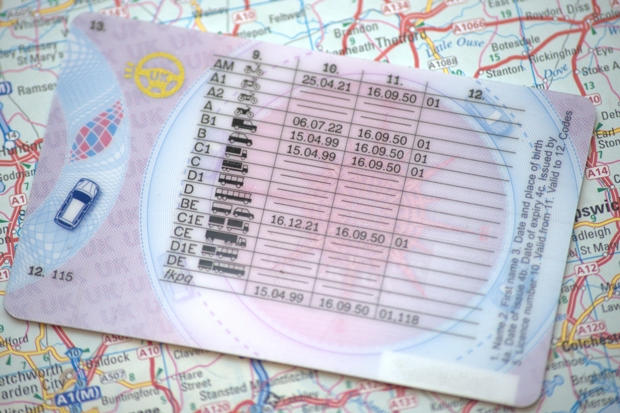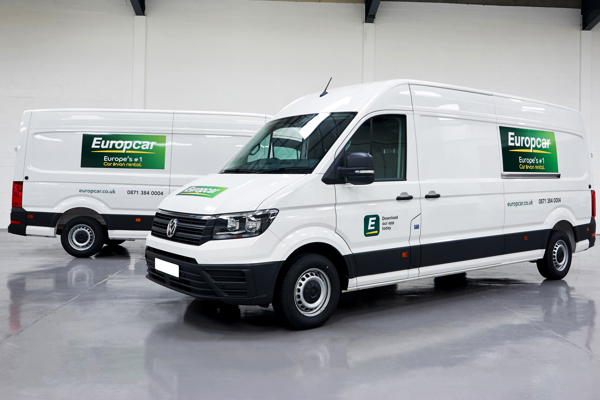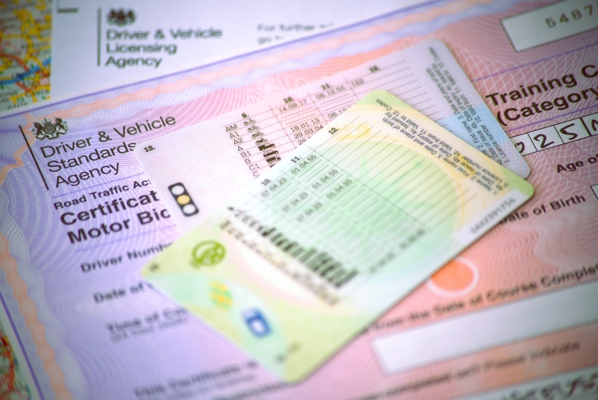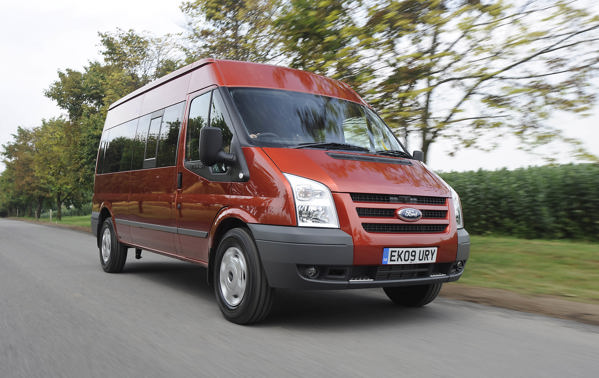What licence do you need to drive a van in the UK?
Want to know what type of vans can be driven on a standard UK driving licence? Confused as to what you are and are not allowed to drive when it comes to vans and minibuses? We explain all...

- Can you drive a 3.5t van on a car licence?
- How to check your licence entitlement
- Why it can be different for electric vans
There are more vans on the UK’s roads than ever before, with an estimated 5.1 million light commercial vehicles in regular use, the majority of them used by businesses both large and small.
You can of course hire a van if you've got something big to transport, or you may be driving a minibus for a school or charity. But while it's easy enough to hire a van, you need to make sure that you are legal to drive it. So working out what you can drive on your driving licence is key.
The good news is that most people can drive a van and there are no additional requirements to drive one, other than holding a full UK driving licence.
In this guide, we explain everything you need to know about driving a van legally and in accordance with your licence.
Can I drive a 3.5 tonne van on a car licence?
If you have a full UK car driving licence, also known as Category B, then yes you can drive a 3.5t van. If you only have an automatic-only car licence then the same applies to vans and you can only drive one with two-pedal transmission.
Category B allows you to drive any van weighing up to 3.5 tonnes (3500kg) gross vehicle weight (GVW). This covers the vast majority of light commercial vehicles (LCVs) on the road, from small vans like the Vauxhall Combo or Volkswagen Caddy right up to most large panel vans like the Mercedes Sprinter and long-wheelbase Ford Transit.
Driving one of these large vans or minibuses may seem very daunting if you are only used to driving a small car for instance. But your licence does allow you.
However, some heavy-duty derivatives of large vans exceed a GVW of 3.5t – converted versions of the Iveco Daily and Renault Master being prime examples.

You need to check the GVW of such vehicles against the V5C Registration Document to be 100% sure you’re within the boundaries of your licence. The most extreme conversions can be as high as 7.0t GVW. As well as on the V5C, if the van is over 3.5t GVW it should also carry a plate or sticker somewhere on the chassis frame, or inside the door shuts.
If you passed your driving test before 1 January 1997, then you may also have C1 entitlement on your licence.
This was automatically granted to drivers who passed their Category B tests before this date and covers you to drive vans up to 7.5 tonnes (7500kg), which covers you for every van on the road and even some small lorries, such as a Mercedes-Benz Atego or DAF LF.
What about electric vans?
Due to the weight of the batteries, electric vans are often heavier than diesel ones. From October 2024, the government has made allowances for this.
Previously, you were required to do online classroom training before being allowed to drive some larger electric models, such as the Mercedes e-Sprinter and Volkswagen e-Crafter. However, a permanent derogation has now been applied to allow standard Category B (car) licence holders to drive an alternative fuel vehicle or AFV of up to 4.25t GVW.
However, while the 4.25t limit applies for electric vans, such as the majority of new supermarket delivery vehicles, it doesn’t allow you to drive petrol or diesel vans up to that limit – they remain at 3.5t.
Who is not permitted to drive a van?
If you have a health condition that can cause sensory issues, such as some types of diabetes, epilepsy or have suffered a stroke, then the DVLA can limit the types of vehicle you are allowed to drive, or stop you from driving altogether.
You will have to undergo what is known as a D4 Driver Medical Assessment with your GP, who will then determine if you are safe to drive or will need any restrictions applied to your licence.
It’s also a criminal offence to not advise DVLA of any health condition you know about that could impair your ability to drive safely.

How do I check my licence entitlement?
You can check the categories you’re licensed to drive by looking at the back of your driving licence. You can also check your licence details on the gov.uk website, for which you’ll need your licence number, National Insurance number and postcode.
If you are hiring a van or driving a fleet vehicle, you may also be asked to provide this information and get a check code from the same resource, to prove your entitlement to drive such vehicles.
Historically, most hire fleets used to keep larger vans such as Luton (box van) conversions and small 7.5t trucks on their fleets as these were often popular for customers using them for house moves or similar.
But due to the dwindling number of people who have pre-1997 Category C1 concessions on their licences, most will no longer have vans greater than 3.5t GVW. If you need a larger vehicle and are allowed to drive one, you may need to use a specialist hire provider.
Driving licence categories for cars and vans
Category B - if you passed your test before 1 January 1997
You’re usually allowed to drive a vehicle and trailer combination up to 8250kg maximum authorised mass (MAM).
You’re also allowed to drive a minibus with a trailer over 750kg MAM.
Category B - if you passed your test on or after 1 January 1997
You can drive vehicles with up to 8 passenger seats with a maximum authorised mass (MAM) of:
- 3500kg for petrol and diesel vehicles - this includes hybrid vehicles
- 4250kg for electric or hydrogen vehicles - zero emission vehicles only
If your electric or hydrogen vehicle has extra equipment for disabled passengers, it can have an additional MAM of 750kg. This additional MAM must only be used for this equipment.
With a petrol, diesel, electric or hydrogen vehicle, you can tow a trailer with a MAM up to 3500kg. The combined MAM of the vehicle and trailer must not exceed 7000kg.
You can drive motor tricycles with a power output higher than 15kW if you are over 21 years old.
Physically disabled drivers with provisional category B entitlement will also have provisional entitlement to ride category A1 or A motor tricycles.
Non-disabled drivers can no longer ride motor tricycles with a provisional category B licence.
Category B auto
You can drive a category B vehicle - but only an automatic one.
Category BE
You can drive a vehicle with a maximum authorised mass (MAM) of 3500kg with a trailer.
The size of the trailer depends on the BE ‘valid from’ date shown on your licence. If the date is:
- before 19 January 2013, you can tow any size trailer within the towing limits of the vehicle
- on or after 19 January 2013, you can tow a trailer with a MAM of up to 3500kg within the towing limits of the vehicle
Medium-sized vehicles
Category C1
You can drive vehicles between 3500kg and 7500kg maximum authorised mass (MAM) (with a trailer up to 750kg).
Category C1E
You can drive C1 category vehicles with a trailer over 750kg.
The combined maximum authorised mass (MAM) of both cannot exceed 12,000kg.
Large vehicles
Category C
You can drive vehicles over 3500kg with a trailer up to 750kg maximum authorised mass (MAM).
Category CE
You can drive category C vehicles with a trailer over 750kg.
Minibuses
Category D1
You can drive vehicles with:
- no more than 16 passenger seats
- a maximum length of 8 metres
- a trailer up to 750kg
Category D1E
You can drive D1 category vehicles with a trailer over 750kg maximum authorised mass (MAM).
The combined MAM of both cannot exceed 12,000kg.
Buses
Category D
You can drive any bus with more than 8 passenger seats with a trailer up to 750kg maximum authorised mass (MAM).
Category DE
You can drive D category vehicles with a trailer over 750kg.
How old do I need to be to drive a van?
Because vans up to 3.5t GVW are subject to the same licensing rules as cars, you can start driving them from as soon as you’ve passed your test – they’re subject to the same age limit of 17 years old. However, many hire companies and fleets have a higher age limit of 18 or even 21, usually due to insurance.
Can I drive a van on a provisional licence?
There’s no reason why you can’t drive a van on a provisional licence, but the same rules apply as when you’re driving a car in such circumstances – you must be correctly insured and be accompanied by a full licence holder who has held their licence for three years or more and is over 21 years of age.

Can I drive a minibus?
Yes, as long as the minibus is under 3.5t GVW and you are not driving it for hire or reward – that is to say you’re not being paid by passengers.
If you are, such as if the minibus is used as a taxi or airport shuttle, then you need to have a minibus permit that allows you to do so. The rule applies to any vehicle with more than nine passenger seats, so you could even be caught out by some vehicles rated for more passengers than that, such as the original Land Rover Defender 110.
To drive one for hire or reward, you must be 21 years of age or older, have had your licence for two years or more and the minibus must be within the 3.5 tonne weight restriction of a regular van – though you can have an additional up to 750kg for disabled access equipment, such as a wheelchair ramp.

Do you need specific van insurance?
You do – but van insurance isn’t a particularly specialist field and most car insurance providers also insure vans, you should shop around just as you do when insuring your car.
Van insurance may also offer extras, such as cover for tools or equipment left in a vehicle overnight when away from home.
Due to the high incidences of van thefts and the size and weight of the vehicles, which can cause greater damage in a collision, van insurance is often higher than it is for cars and can have a particular impact on younger drivers.
What do I need to be aware of when driving a van?
Although the majority of modern vans are great to drive, some of the larger models in particular may take some getting used to. They often don’t have a rear window either, so you need to be fairly disciplined about driving with your side mirrors.
Be aware of the height – most car park barriers and even some low bridges are too low for larger vans.
On the open road, bear in mind that a van often has a larger blind-spot on each rear quarter, so be extra-vigilant when changing lanes. You’ll often need to take a wider swing at road junctions as longer wheelbase vans will bring the back end in if you don’t make allowances, meaning you can bump kerbs or, worse, hit something with the back end of your van.
Most modern vans have cameras and sensors to mitigate this and the vast majority are easy to drive.
Remember that vans have different speed limits to cars. On national speed limit roads, you’re limited to 50mph on single carriageway roads and 60mph on dual carriageways, though you are still allowed to drive at 70mph on a motorway.
